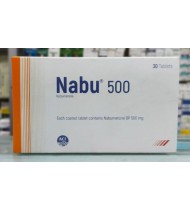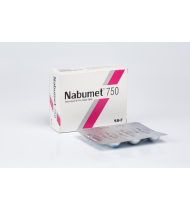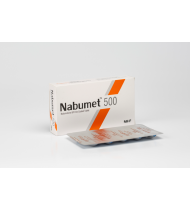Nabumetone
Indications
Pharmacology
The parent compound is a prodrug, which undergoes hepatic biotransformation to the active component, 6-methoxy-2-naphthylacetic acid (6MNA), that is a potent inhibitor of prostaglandin synthesis, most likely through binding to the COX-2 and COX-1 receptors.
Dosage & Administration
Interaction
Contraindications
Side Effects
Central Nervous System: Dizziness, headache, fatigue, increased sweating, insomnia, nervousness, somnolence.
Dermatologic: Pruritus, rash
Special Senses: Tinnitus
Miscellaneous: Edema
Pregnancy & Lactation
Nursing Mothers: It is not known whether this drug is excreted in human milk, however 6MNA is excreted in the milk of lactating rats. Because many drugs are excreted in human milk and because of the potential for serious adverse reactions in nursing infants from Nabumetone, a decision should be made whether to discontinue nursing or to discontinue the drug, taking into account the importance of the drug to the mother.
Labor and Delivery: In rat studies with NSAIDs, as with other drugs known to inhibit prostaglandin synthesis, an increased incidence of dystocia, delayed parturition, and decreased pup survival occurred. The effects of Nabumetone on labor and delivery in pregnant women are unknown.
Precautions & Warnings
Use in Special Populations
Geriatric Use: As with any NSAIDs, caution should be exercised in treating the elderly (65 years and older).
Overdose Effects
Patients should be managed by symptomatic and supportive care following a NSAIDs overdose. There are no specific antidotes. Emesis and/or activated charcoal (60 to 100 grams in adults, 1 to 2 g/kg in children), and/or osmotic cathartic may be indicated in patients seen within 4 hours of ingestion with symptoms or following a large overdose (5 to 10 times the usual dose). Forced diuresis, alkalinization of urine, hemodialysis, or hemoperfusion may not be useful due to high protein binding.
There have been overdoses of up to 25 grams of Nabumetone reported with no long-term sequelae following standard emergency treatment (i.e., activated charcoal, gastric lavage, IV H2-blockers, etc.).
Therapeutic Class
Storage Conditions
Elivier Tablet 500 mg
IndicationsNabumetone is indicated for relief of signs and symptoms of osteoarthritis and rheumatoid..
15.00Tk.
Nabu Tablet 500 mg
IndicationsNabumetone is indicated for relief of signs and symptoms of osteoarthritis and rheumatoid..
15.00Tk.
Nabu Tablet 750 mg
IndicationsNabumetone is indicated for relief of signs and symptoms of osteoarthritis and rheumatoid..
22.00Tk.
Nabumet Tablet 750 mg
IndicationsNabumetone is indicated for relief of signs and symptoms of osteoarthritis and rheumatoid..
22.00Tk.
Nabumet Tablet 500 mg
IndicationsNabumetone is indicated for relief of signs and symptoms of osteoarthritis and rheumatoid..
15.00Tk.
Nabuton Tablet 500 mg
IndicationsNabumetone is indicated for relief of signs and symptoms of osteoarthritis and rheumatoid..
15.00Tk.
Nabuton Tablet 750 mg
IndicationsNabumetone is indicated for relief of signs and symptoms of osteoarthritis and rheumatoid..
22.00Tk.





